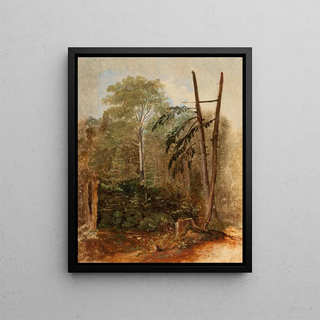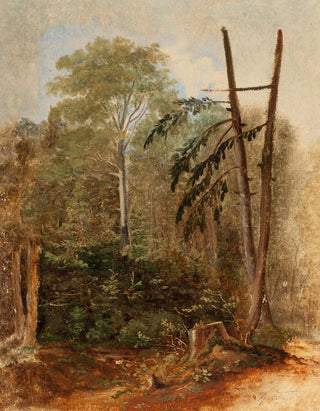Painting Study of a wooded landscape - Carl Spitzweg | Art print


View from behind

Frame (optional)
In the fascinating world of art, some works manage to capture the very essence of nature, evoking deep emotions and serene contemplation. The art print "Étude d'un paysage boisé" by Carl Spitzweg is a perfect example. This painting, imbued with poetry, transports us to the heart of a lush forest, where light plays with the foliage and every detail seems to breathe tranquility. By admiring this piece, the viewer is invited to immerse themselves in a world where time stands still, where the beauty of the landscape reminds us of the simplicity and grandeur of nature. The artist, through his mastery of nuances and textures, succeeds in making this study a true hymn to serenity and harmony.
Style and uniqueness of the work
Carl Spitzweg, known for his romantic style and his ability to capture scenes of everyday life, stands out here with an almost impressionistic approach to nature. In "Étude d'un paysage boisé," delicate brushstrokes and subtle hues create an atmosphere of calm. The trees, majestic and well-drawn, seem to dance under the breath of a gentle breeze, while light filters through the foliage, casting soft shadows on the ground. This art print does not merely depict a landscape; it evokes a sensation, an immersive experience that appeals to our senses. The color palette chosen by Spitzweg, oscillating between deep greens and golden touches, contributes to this soothing ambiance, making each view a sensory journey.
The artist and his influence
Carl Spitzweg, an emblematic figure of the German Romantic movement, managed to leave his mark on his era with a unique approach to painting. Born in 1808, he initially worked as a pharmacist before fully dedicating himself to art. His passion for nature and his interest in scenes of everyday life are reflected in his works, which blend realism and poetry. Spitzweg has inspired many artists, and his influence endures to this day. By incorporating elements of rural life and natural landscapes into his creations, he paved the way for a new appreciation

Matte finish

View from behind

Frame (optional)
In the fascinating world of art, some works manage to capture the very essence of nature, evoking deep emotions and serene contemplation. The art print "Étude d'un paysage boisé" by Carl Spitzweg is a perfect example. This painting, imbued with poetry, transports us to the heart of a lush forest, where light plays with the foliage and every detail seems to breathe tranquility. By admiring this piece, the viewer is invited to immerse themselves in a world where time stands still, where the beauty of the landscape reminds us of the simplicity and grandeur of nature. The artist, through his mastery of nuances and textures, succeeds in making this study a true hymn to serenity and harmony.
Style and uniqueness of the work
Carl Spitzweg, known for his romantic style and his ability to capture scenes of everyday life, stands out here with an almost impressionistic approach to nature. In "Étude d'un paysage boisé," delicate brushstrokes and subtle hues create an atmosphere of calm. The trees, majestic and well-drawn, seem to dance under the breath of a gentle breeze, while light filters through the foliage, casting soft shadows on the ground. This art print does not merely depict a landscape; it evokes a sensation, an immersive experience that appeals to our senses. The color palette chosen by Spitzweg, oscillating between deep greens and golden touches, contributes to this soothing ambiance, making each view a sensory journey.
The artist and his influence
Carl Spitzweg, an emblematic figure of the German Romantic movement, managed to leave his mark on his era with a unique approach to painting. Born in 1808, he initially worked as a pharmacist before fully dedicating himself to art. His passion for nature and his interest in scenes of everyday life are reflected in his works, which blend realism and poetry. Spitzweg has inspired many artists, and his influence endures to this day. By incorporating elements of rural life and natural landscapes into his creations, he paved the way for a new appreciation
12,34 €






